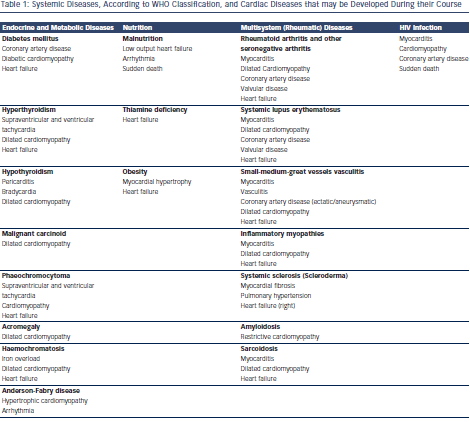Introduction on Clinical Use of Cardiac Magnetic Resonance in Systemic Heart Disease
Systemic means ‘pertaining to or affecting the whole body’ as opposed to a localised condition. A systemic disease is one that affects a number of organs and  tissues, or the body as a whole. Systemic diseases, according to WHO classification,1 and cardiac diseases that developed during their course, are listed in Table 1.
tissues, or the body as a whole. Systemic diseases, according to WHO classification,1 and cardiac diseases that developed during their course, are listed in Table 1.
Thyroid diseases, pheochromocytoma and growth hormone excess may contribute to usually reversible dilated cardiomyopathy.2 Hereditary haemochromatosis is an inherited disorder of iron metabolism; if left untreated, leads to tissue iron overload, iron cardiomyopathy and heart failure. Cardiac amyloidosis is the result of amyloid deposition in the heart, formed from breakdown of normal or abnormal proteins that lead to increased heart stiffness, restrictive cardiomyopathy and heart failure. Finally, nutritional disturbances and metabolic diseases, such as Kwashiorkor, Beri-beri, obesity and diabetes mellitus may also lead to dilated cardiomyopathy and heart failure.3
Cardiovascular involvement is a common and underestimated problem in multisystem (rheumatic) diseases and may present with disease associated cardiac involvement at diagnosis or later in the course of the systemic disease. It usually has a silent or oligo-symptomatic cardiac presentation and includes different pathophysiological mechanisms such as, myocardial inflammation, infarction, diffuse, subendocardial vasculitis, valvular disease and different patterns of fibrosis; furthermore, acuity of heart involvement may be underestimated due to non-specific cardiac signs, and most of patients are female and unable to exercise due to arthritis or muscular discomfort/weakness or may have limited acoustic window due to increased breast size.4
Finally, HIV-infected patients have an increased risk of coronary artery disease (CAD) and myocardial inflammation frequently leading to heart failure. This is due to different factors including: conventional risk factors, HIV-specific processes driving inflammation, coagulation and endothelial dysfunction.5
Cardiovascular magnetic resonance (CMR) through its ability to reliably assess cardiac anatomy, function, inflammation, stress perfusion-fibrosis, aortic distensibility, and iron and fat deposition, constitutes an excellent tool for early diagnosis of cardiovascular involvement, risk stratification, treatment evaluation and long-term follow-up of patients with cardiovascular disease due to systemic diseases.